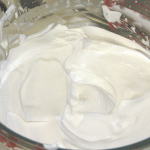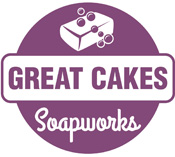The Latest Facial Moisturizing Cream
 I created a new facial moisturizing cream today using ingredients that I already had in my soaping cupboard. However, I have also ordered more specialty items to test another formula. These are scheduled to arrive on Friday. Today’s recipe includes neroli (aka orange blossom) hydrosol, aloe vera juice, shea butter, jojoba oil, shea oil, avocado oil, evening primrose oil; also tamarind and cranberry extracts and vitamin E and a few other ingredients. It is very thick, as you can see.
I created a new facial moisturizing cream today using ingredients that I already had in my soaping cupboard. However, I have also ordered more specialty items to test another formula. These are scheduled to arrive on Friday. Today’s recipe includes neroli (aka orange blossom) hydrosol, aloe vera juice, shea butter, jojoba oil, shea oil, avocado oil, evening primrose oil; also tamarind and cranberry extracts and vitamin E and a few other ingredients. It is very thick, as you can see.
Here is some basic information about making emulsions (combining water and oil with an emulsifier), for those of you who are interested:
1. In order for the water soluble ingredients to combine with the oil soluble ingredients, you need an emulsifer. One of the most stable emulsifiers is called “emulsifying wax”. It comes in little creamy colored pastilles that must be melted with the oil soluble ingredients.
2. If you want to have a thin lotion, you use more water soluble ingredients. If you want a thicker cream, you use a higher percentage of oil soluble ingredients. This can also be achieved by using vegetable butters such as cocoa butter, or oils that are solid at room temperature such as coconut oil. One of the specialty ingredients that I ordered is an extra virgin coconut oil that is only lightly processed and still smells like fresh coconut.
3. All of the equipment used to make the lotion or cream must be sterilized. Any time water soluble ingredients are used, this is an open door for bacteria. The water soluble ingredients should also be heated to a tempurature of 170 degrees to kill any bacteria that might already be living in them. Which leads to the next point…
4. Emulsions must be preserved. Preservatives come in many different varieties. Paraben preservatives have gotten a bad rap for allegedly being linked to cancer, although I’ve recently heard that the evidence supporting this is inconclusive. Most of the preservatives found in bath and body products at the store contain a chemical preservative, usually with parabens. I use a non-paraben preservative in all my lotions, just to be on the safe side. There are some new naturally derived preservatives that have come on the market, but most are either difficult to work with, must be combined with a synthetic preservative to be effective, or they stink! Literally. One of the other specialty ingredients coming in my shipment on Friday is a natural preservative called Tinosan. It contains citric acid and silver citrate – that’s it. I’ve heard good things about Tinosan, so I’m anxious to test it for myself.
Stay tuned for more information about my quest for the “perfect” facial moisturizing cream formula! I may be needing some testers…
Page with Comments
Comments are closed.

I’ll be a tester! I’ve been waiting for you to work on a facial moisturizer! Let me know when it’s ready, I can’t wait!